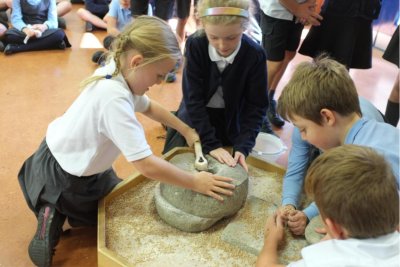Sustain / Real Bread Campaign / Articles
Playing fields of wheat
School gardening club leader, Liz Read, tells the story of how children grew wheat on their playing field.

The project at Holy Trinity Primary Academy in Wiltshire was sparked in October 2017 when local farmer, Emily Pepler (now Greening), gave a talk at a school assembly. She said that our large playing field could produce enough wheat for approximately 15,000 loaves of bread, about one from each square metre. The children thought this was an amazing idea and were disappointed that Mercedes Henning, the headteacher, was not going to give permission to plough the whole thing up! Given the pupils’ disappointment, she and I devised a whole school project around growing a smaller plot of wheat.
The Real Bread Campaign’s original Bake Your Lawn guide was really useful, giving us the information, confidence and inspiration to give the project a go. The maintenance contractors rotovated two spaces in the playing field, each about 3 metres by 2 metres. A grass path was left in the middle to allow us access to care for the wheat. The path was the same width as the gang mower used to maintain the playing field, ensuring it could be trimmed easily.
Let the sky fall, we will stand tall*
Emily provided some Skyfall wheat, which is one of the most widely grown breadmaking varieties in the UK, and I arranged with the school that all of the pupils could help plant the seed. In March 2018, we took the children out a class at a time, each child sowing a small number of seeds by hand. Skyfall is a winter, rather than spring, variety and we had accepted that our seeds might not produce much of a crop when sown this late. In fact, we weren’t even sure if the seeds would grow at all. If this had happened, we would have talked with the children about crop failure, what causes it and the consequences for people.
Happily, the wheat grew steadily on the playing field with only a little weeding needed. We gave it no attention over the summer holidays but it was still standing when school returned in September. The children harvested the ripe wheat with their classroom scissors, gathering the very dry and crackly ears in the baskets. The wheat stalks were just mowed by the maintenance team and grass regrew over the plots, leaving no trace of the project.
Harvest festival
At the next assembly, I gave a short talk on the processes so far - ploughing the earth, planting the wheat and harvesting it. The whole school then threshed the ears of wheat by covering them with a tarpaulin and walking up and down over it. This was really effective and a lot of fun. The children winnowed the wheat in the playground using tea towels and sieves to remove the chaff, before grinding the wheat with a small hand-cranked mill. They then made their own Real Bread, each having a chance to knead the communal batch of dough, which was made into a wheatsheaf loaf for the school harvest festival.
Cross-curricular activity
The school used the project as a topic for lessons and activities across the curriculum. The Wiltshire Museum introduced a historical perspective by bringing in agricultural implements. These included two types of stone quern, which the children were able to examine and try using to mill wheat. They also saw a huge scythe, measuring jugs and sieves. This helped the children look at the changing technology used to grow and harvest wheat, appreciate the hard work it took to grind grain by hand. As it is a rural school and some children are in farming families, it helped create a sense of connection with previous generations.
The crochet club made long, woollen chains, to which CDs were attached to ward off birds. The children studied the art of David Hockney, whose work included paintings of wheat fields, and some classes created their own paintings based on this. Religion was explored through the story of Ruth the gleaner.
Enthusiasm and excitement
It was a truly wonderful project and was covered in the local paper, parish newsletter and through talks to local gardening clubs. It had come from the spontaneous enthusiasm of the children, who were included at every stage, and created excitement within the school and elsewhere.
Mrs. Henning said: "It has been a really amazing project and has helped the children to understand a lot more about food production and farming. Every child has benefited and has enjoyed watching the whole journey of wheat from tiny seed to warm loaf."
If we had run the project again, we might have used older varieties to help the children consider changes in wheat and farming over time. Soon after the project was completed, however, lockdown closed the school. When it re-opened, the school had a new headteacher with new priorities and plans. We are so glad we took the chance to grow the wheat and will always look back with huge fondness on baking our lawn.
*Okay, rather than being a tall, long-straw heritage wheat, Skyfall is a modern, dwarfed variety, but I couldn’t resist using an Adele / Bond theme lyric. ed.
Originally published in True Loaf magazine issue 56, October 2023.
Are you ready to Bake Your Lawn?
Check out the Real Bread Campaign's grow-a-loaf guidebook.
See also
- From seed to sourdough
- Seed to sandwich in Shaky Toon
- Bakers’ bush
- A breaducation
- Class act
- Home grown loaf
- Grassroots grain Britain
Published Monday 18 March 2024
Real Bread Campaign: The Real Bread Campaign finds and shares ways to make bread better for us, better for our communities and better for the planet. Whether your interest is local food, community-focussed small enterprises, honest labelling, therapeutic baking, or simply tasty toast, everyone is invited to become a Campaign supporter.

